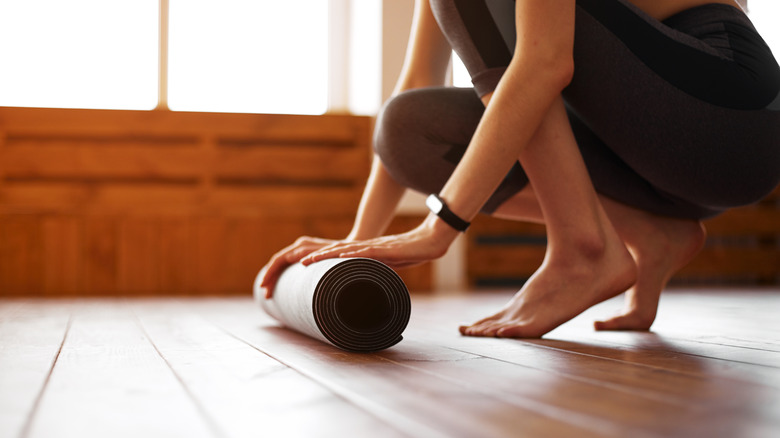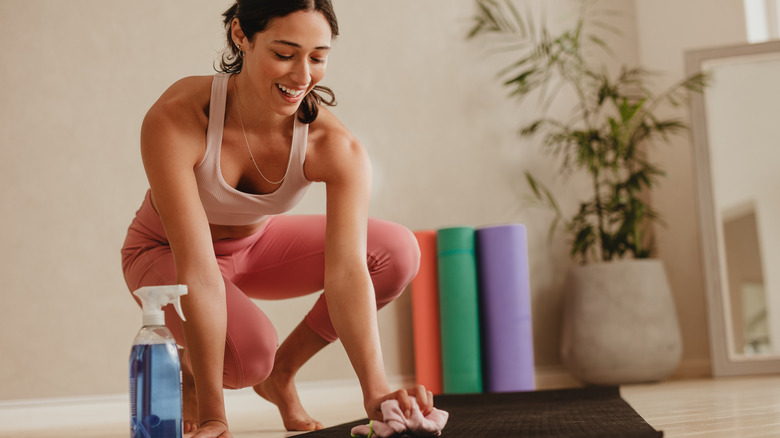Why You Might Not Want To Roll Up Your Yoga Mat Immediately After A Class
Anyone who loves to get a good workout knows how crucial it is to have the right equipment with you. After all, it sets you up to get a great workout session. Part of having the proper equipment is to keep your workout gear in good shape. Just as you wouldn't wear dirty clothes to the gym the day after, you don't want to keep reusing grimy equipment after each workout session. However, depending on the activity you have, you'll have to consider how to clean and store various objects. Those into cardio, for example, will have different belongings to care for than those who are into pilates or yoga. While we always think of gear as dumbbells or barbells, there's another crucial piece of equipment that deserves our attention — the yoga mat.
It is an essential piece for anyone practicing yoga. Not only will a yoga mat keep you cushioned and stable during your session, but it's also your designated safe space to relax in during yoga. Therefore, keeping it clean and well-preserved will help you continue your practice without having to constantly repurchase a new mat every few weeks.
The truth behind your sweaty yoga mat
Whether you do a five-minute or 50-minute yoga session, odds are that you will be sweating during your session. The sweat will accumulate on your yoga mat, making it a less-than-clean surface. Even if you are in a hurry, you never want to roll up your mat and leave right after the end of your yoga session. This is because the leftover sweat and dirt accumulated on the mat will potentially create bacterial growth, which can create mildew and mold. A moist and dirty surface is the ideal space for bacteria to grow over time, even if it isn't immediately visible. So, before rolling it up, wipe it down or let it dry before picking it up.
Even though you'll want to be consistent with the cleaning of your mat, especially after a sweaty session, you'll want to at least do a thorough cleaning every few sessions. Since bacteria and viruses can reproduce, a full cleanse will stop these microorganisms from creating greater havoc on your yoga mat. Therefore, drying it off before rolling it up will help avoid the progression of mold and bacteria, which will let you utilize your mat for a longer time.
How to properly clean your yoga mat
Cleaning your yoga mat doesn't need to be a cause for a headache. While the easiest way is to purchase yoga wipes that you can simply use after each session, you don't even need any specific wipe to get a clean yoga mat. If you don't have any yoga cleaning wipes on hand, Masterclass recommends using a microfiber towel to help spot-dry your mat after each use. Using a microfiber towel, wipe down both sides of your mat to prevent any bacteria from growing in between a deep cleanse. Once you are able to, let your yoga mat extend for it to dry off completely.
Every few sessions you want to give your yoga mat a deep cleanse to ensure it remains safe and clean. Depending on how often you use your yoga mat, you can extend or shorten the amount of time between washes. A deep cleanse can include any cleaning spray or wipes and taking the time to clean every inch of your yoga mat. You can also create your own homemade yoga mat cleaner by mixing equal parts of vinegar and water to make your solution. Then wipe down the solution with a microfiber and let the yoga mat dry before rolling it up and storing it away. No matter what cleaning solution you use on your yoga mat, ensure it is safe for human usage, as you will be stretching, kneeling, and laying on the mat.


